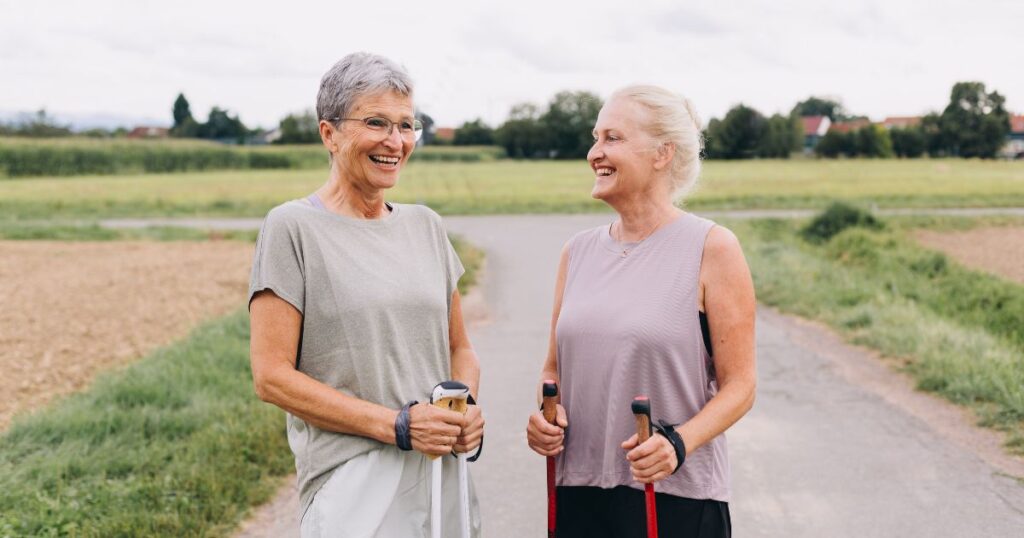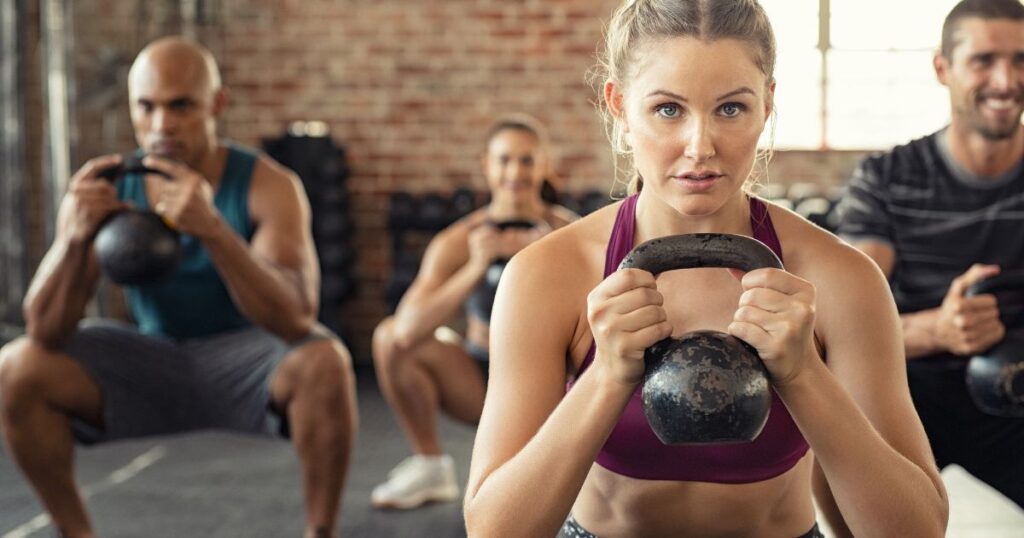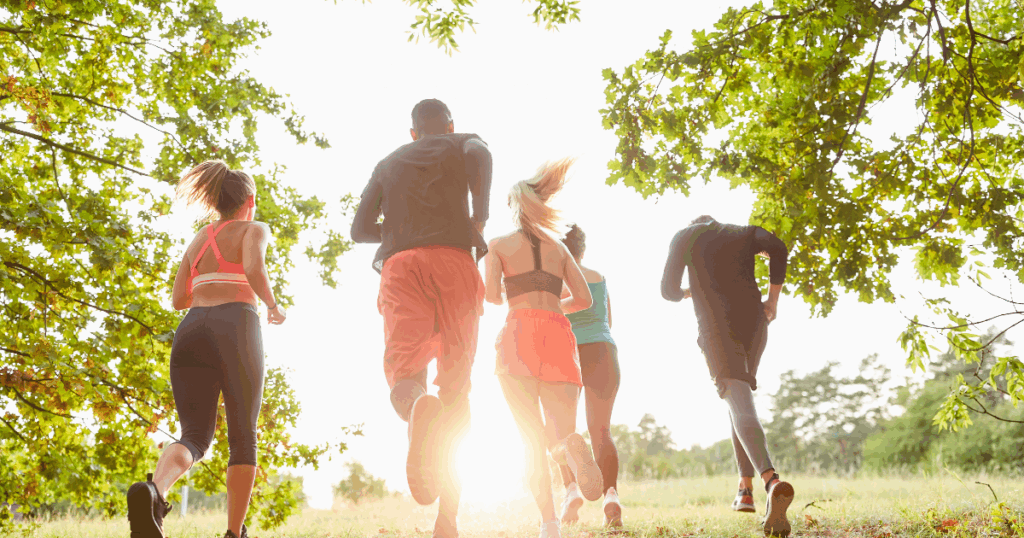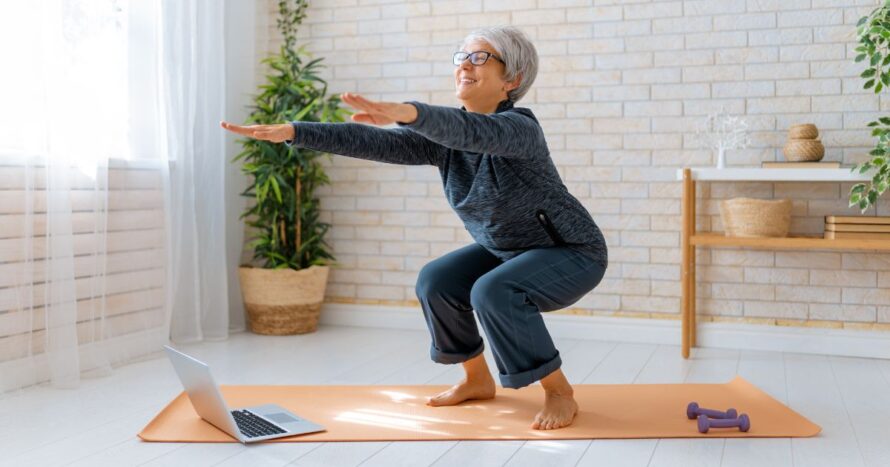A weighted vest is a fitness tool that adds extra resistance to your body by evenly distributing weight across your torso. By making your muscles work harder during everyday movements—like walking, running, or bodyweight exercises—it can help you burn more calories, build muscle endurance, strengthen bones, and improve posture and balance.
Weighted vests aren’t just for athletes. Research shows they may help preserve muscle mass during weight loss, maintain bone density in older adults, and even support metabolic and cardiovascular health. Some types are also used for sensory support in autism and ADHD, thanks to their calming, deep-pressure stimulation.
As a women’s health expert and board-certified naturopathic endocrinologist, I recommend weighted vests as one of the simplest ways to support strength and bone health, especially for women in midlife. Just 20–30 minutes of walking with a light vest can help maintain muscle mass and improve posture without high-impact exercise.
If you’re wondering whether a weighted vest can help you lose belly fat, build strength, or safely improve bone health, this guide breaks down the top benefits, best vests for different goals, and how to use one safely.
In this article:
- What Are Weighted Vests Good For?
- Best Weighted Vests for Different Goals
- Benefits of a Weighted Vest While Walking & Running
- Do Weighted Vests Work for Weight Loss and Fat Loss?
- Weighted Vest for Osteoporosis & Strengthening Your Bones
- Weighted Vests for Women: Finding the Right Fit
- Autism Weighted Vests: A Tool for Sensory Support
- Are Weighted Vests Bad for You in Any Way?
- Weighted Vest FAQs
- Final Thoughts on the Benefits of a Weighted Vest
What Are Weighted Vests Good For?
A weighted vest is exactly what it sounds like: a vest with added weight that can be adjusted to your fitness level.
Wearing a weighted vest increases resistance in your workouts by weighing down your body and making your muscles work harder. It can help to strengthen muscles in your core, back, and legs, and also improve bone density and cardiovascular endurance.
Before diving into more details, here are some key facts to know about weighted vests:
- Weight capacity: Most vests range from 5 to 50 lbs., with adjustable options to customize the resistance based on your needs. A general guideline is to choose a vest that's no more than 10 percent of your body weight (meaning if you’re 150 lbs., start with a vest that's 15 lbs.).
- How they’re worn: Weighted vests are designed to be worn snugly over the torso (like a typical vest), distributing weight evenly around your back and core for comfort, safety, and effectiveness.
- Who they're best for: People looking to increase endurance, improve bone density, enhance weight loss, or boost strength training can all benefit from weighted vests.
- Cost range: Prices vary depending on the weight capacity and design, typically ranging from $40 to $300.
- Types available: Options include adjustable weighted vests for women, running vests, and sensory vests for autism. This is the one I use and have found to be most comfortable.
- Materials: High-quality vests are table with breathable fabric, reinforced stitching, and sandbag or metal weight inserts for durability and comfort while wearing them.
- Precautions: It's important to make sure the vest is not too heavy and fits well, and to avoid wearing it for prolonged periods to prevent too much strain on the spine and joints. If you're injured, especially in the spine or legs, talk to your doctor or physical therapist before trying a weighted vest.
Best Weighted Vests for Different Goals
| Goal | Recommended Weight | Best Type of Weighted Vest | Notes |
| Walking for Weight Loss | 5–10% of body weight | Adjustable, breathable walking vest | Start light to avoid joint strain; great for increasing calorie burn without high-impact exercise. |
| Bone Health & Osteoporosis Support | 5–8% of body weight | Snug-fitting, low-impact vest | Focus on weight-bearing movements like walking or stair climbing; consult a doctor if you have severe osteoporosis. |
| Running or Jogging | 5–8% of body weight (start lower) | Lightweight, slim running vest | Choose a vest designed for running to prevent bouncing; gradually increase weight to improve stamina. |
| Strength & Endurance Training | 8–15% of body weight (advanced users can go higher) | Heavy-duty adjustable training vest | Best for bodyweight exercises like squats, lunges, or pull-ups; builds muscle strength and core stability. |
| Everyday Metabolic Boost (wearing around the house) | 5–10 lbs. | Comfortable daily-wear vest | Keep sessions short (20–60 minutes); avoid prolonged sitting or wearing for hours to prevent spinal strain. |
| Sensory Support (Autism, ADHD, Anxiety) | 2–10 lbs. (based on comfort) | Sensory/deep pressure vest | Provides calming proprioceptive input; should be worn in short intervals for focus and regulation. |
Benefits of a Weighted Vest While Walking & Running
Adding a weighted vest to your daily walks, jogs, or runs is one of the easiest ways to increase calorie burn and build strength without spending extra time in the gym.
For example, one doctorate in exercise physiology explained to New York Magazine that “a brisk walk with the dog with the addition of a weighted vest can give you a reasonably good cardiovascular workout without the need to find time to attend the gym…the vest increases your body weight, making the muscles you use to walk work harder—from your feet and ankles to your knees, hips, and spine. You’re basically working every single muscle of your body a bit harder, except for your arms.”
When you wear a weighted vest while walking or even going about your regular day, you help:
- Boost calorie burn by increasing energy expenditure.
- Build muscle strength and endurance without needing to do high-impact exercises.
- Support better posture and core stability by engaging core muscles more intensely.
- Maintain bone density, reducing the risk of osteoporosis.
- Improve mobility and balance by building core stability.
- Support cardiovascular and metabolic health.
In one study that included 37 older, obese adults who followed a 22-week diet program aimed at losing 10% of their body weight, participants who wore weighted vests throughout the day built more muscle mass and strength. The participants were split into two groups: one that wore a weighted vest daily (Diet+Vest) and one that did not use a vest (Diet only). The goal was to see if wearing a vest helped maintain muscle strength and physical function during weight loss.
Both groups lost a similar amount of weight (about 24 lbs. or 11 kg), and there were no significant differences in fat loss or body composition between them. However, the Diet-only group experienced a greater decrease in leg power and lower body muscle mass—suggesting that the weighted vest might help preserve muscle function during weight loss, which is key for long-term metabolic health.
Can You Wear a Weighted Vest While Running?
For those looking for a more challenging workout that builds stamina, running or jogging with a weighted vest can be a good option, although it's difficult! It’s important to start slow and gradually increase the weight gradually to avoid hurting yourself.
Benefits of running or jogging with a weighted vest can include:
- Improving cardiovascular fitness by making the heart work harder.
- Enhancing leg strength and power over time.
- Boosting running abilities and speed, making your body more efficient at endurance activities.
- Encouraging fat loss by increasing energy expenditure.

Do Weighted Vests Work for Weight Loss and Fat Loss?
If weight loss or losing belly fat is one of your main goals, a weighted vest may be a great tool to invest in.
By adding extra resistance to everyday movements, your body builds more muscle and burns more calories, leading to greater energy expenditure. A study published in The Lancet found that wearing a weighted vest resulted in greater calorie burn in overweight adults, which helped to reduce body weight and fat mass.
If you're working on losing weight but don't enjoy typical weight-lifting sessions, trying a weighted vest for fast loss instead can be a good idea. That said, ultimately your diet is still very important when it comes to weight loss.
Potential benefits of wearing a weighted vest for weight loss can include:
- Increasing your metabolic rate and fat-burning potential by building more muscle.
- Ramping up your workout intensity without the need for high-impact movements.
- Supporting lean muscle retention, which is crucial for sustainable fat loss.
In addition to helping you reach a healthier weight, studies show that weighted vests can help protect heart health, including by reducing insulin resistance and cardiovascular disease risk factors in both normal and obese women.
Related:
Tips to Help With Menopause Weight Loss
How to Lose Weight During Perimenopause
Why Eat Less and Exercise More is Bad Advice for Women
Weighted Vest for Osteoporosis & Strengthening Your Bones
One of the most overlooked benefits of a weighted vest is its impact on bone density.
Weight-bearing exercises are critical for maintaining strong bones, especially as you age—since increased age increases the risk for sarcopenia (loss of muscle mass) and bone loss. A weighted vest for osteoporosis can help stimulate bone growth and reduce the risk of fractures, falls, and bone density loss.
In addition to increasing bone density through weight-bearing resistance, a weighted vest is helpful for
- Supporting proper posture and balance, reducing fall risk
- Serving as a low-impact alternative to weightlifting for bone strength
Keep in mind: the real key to keeping your bones strong as you age is combining weight-bearing exercises with a healthy diet and adequate nutrient intake—including getting enough protein, calcium, and vitamin D (the building blocks of muscle tissue and strong bones).
Pairing a weighted vest with a nutrient-dense diet and proper supplementation can go a long way in supporting bone health.
For example, my Women’s Twice Daily multivitamin and Vitamin D3/K2 dropper both help support calcium absorption and bone density, making them beneficial additions to your daily routine, particularly once you reach your 50s and beyond.
Related: How Much Protein Should Women Have and Breakfast with 30 grams of Protein for Hormone Balance.

Weighted Vests for Women: Finding the Right Fit
Not all weighted vests are designed for women’s bodies, which is why an adjustable weighted vest for women is usually the better option. Women tend to have shorter torsos and different weight distribution needs, so selecting the right fit is essential for comfort and effectiveness.
If you're specifically looking for a weighted vest for women, find a vest with:
- Adjustable weights to scale your resistance over time, ensuring you can start light and increase gradually.
- A comfortable, form-fitting design that sits properly on the shoulders and chest without causing discomfort or excessive pressure.
- Breathable materials like mesh or moisture-wicking fabric to prevent overheating, especially during long workouts.
- Wide, padded shoulder straps to distribute weight evenly and reduce strain on the neck and back.
- Secure fastenings and buckles to keep the vest in place, allowing for full mobility.
Autism Weighted Vests: A Tool for Sensory Support
Weighted vests aren’t just for fitness. An autism-weighted vest provides deep pressure stimulation, which can have a calming effect on the nervous system. This type of vest is often used as part of sensory integration therapy for individuals with sensory processing challenges, autism, or ADHD.
Benefits of a weighted vest for someone with autism, ADHD, or anxiety can include:
- Promotes calmness and focus by stimulating the nervous system’s proprioceptive input, helping people to feel more grounded.
- Supports sensory integration, reducing overstimulation in noisy or busy environments.
- Can improve attention and reduce restlessness in both children and adults, potentially aiding in school, work, and daily activities.
- Encourages self-regulation by helping people to manage emotional responses to sensory triggers.
- Available in different weights to suit individual needs, typically ranging from 2 to 10 lbs.

Are Weighted Vests Bad for You in Any Way?
While weighted vests offer numerous benefits, they can potentially cause issues if used improperly or worn when you have existing injuries. Here are some potential drawbacks and precautions to keep in mind:
- Excessive weight can strain joints and muscles, so stick to about 10% of your body weight to avoid stress on the spine and knees.
- A poor fit can cause discomfort or restricted movement. A vest that is too tight or bulky may lead to shoulder and back pain, so ensure it fits well and feels comfortable.
- Weighted vests are not suitable for everyone. People with pre-existing back issues, joint pain, or severe osteoporosis should consult a healthcare professional before use.
- Too much resistance exercise can increase fatigue if worn too long, so it’s best to use a weighted vest for exercise sessions only or work your way up slowly to wearing one throughout the day.
- Improper posture while wearing a vest can lead to injury, so be sure to maintain proper alignment and engage core muscles to distribute weight effectively.
Related: Understanding Red S: The Hidden Health Risk for Athletes and Active Individuals.
Weighted Vest FAQs
Yes, weighted vests can help with belly fat loss, but they’re not a magic solution. By adding extra resistance to daily movements and workouts, they increase calorie burn and help build lean muscle mass, which boosts metabolism. However, diet and overall energy balance remain key for fat loss—pairing a weighted vest with strength training and a nutrient-dense diet will give the best results.
Yes, when used correctly, weighted vests can be an excellent tool for women with osteoporosis. Weight-bearing resistance helps stimulate bone growth and maintain bone density, reducing fracture risk. Start with a light vest (5–10% of body weight), ensure it fits snugly, and focus on walking or low-impact movements. Always consult a healthcare provider before starting if you have severe bone loss or spinal issues.
The best weighted vest for walking is lightweight, adjustable, and designed for comfort during long wear. Look for:
– Adjustable weight options so you can gradually increase resistance
– Breathable, moisture-wicking fabric to prevent overheating
– Snug, form-fitting design that doesn’t shift while walking
– Wide, padded shoulder straps to reduce pressure on the neck and shoulders
For women, a vest specifically designed for shorter torsos and chest comfort is ideal.
You can wear a weighted vest for short daily activities, but wearing it all day is not recommended. Prolonged use can strain the spine, joints, and muscles, especially if the vest is too heavy. Start with 20–30 minutes during walking or light activity, then gradually increase duration as tolerated. Avoid sleeping or sitting for long periods with it on.
Weighted vests can help with both. By adding resistance, they make muscles—especially in the legs, core, and back—work harder, which can improve muscle endurance and strength over time. They also increase energy expenditure, helping to burn more calories. For significant muscle gains, pair vest use with targeted strength training.
Most experts recommend starting with 5–10% of your body weight. For example, if you weigh 150 lbs., begin with a 10–15 lb. vest. Starting too heavy can strain joints and alter posture, so increase weight gradually as your strength and endurance improve.
Final Thoughts on the Benefits of a Weighted Vest
- Whether you’re looking to boost fitness, lose weight, improve bone health, or enhance endurance and performance, a weighted vest can be a powerful tool when used correctly.
- If you’re considering adding a weighted vest to your fitness routine, start light, listen to your body, and work your way up gradually.
- Pairing a weighted vest with a healthy diet and the right supplements, like Women’s Twice Daily Multivitamin and Vitamin D3/K2, ensures that your body gets the necessary nutrients to support strong bones and muscle function.
